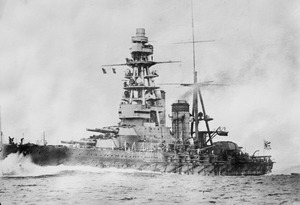Nagato-class battleship

Mutsu at sea about 1922
|
|
| Class overview | |
|---|---|
| Name: | Nagato class |
| Operators: |
|
| Preceded by: | Ise class |
| Succeeded by: | Tosa class |
| Built: | 1917–21 |
| In service: | 1920–45 |
| Completed: | 2 |
| Lost: | 1 |
| General characteristics (as built) | |
| Type: | Dreadnought battleship |
| Displacement: | 32,720 t (32,200 long tons) (standard) |
| Length: | 215.8 m (708 ft 0 in) (o/a) |
| Beam: | 29.02 m (95 ft 3 in) |
| Draft: | 9.08 m (29 ft 9 in) |
| Installed power: |
|
| Propulsion: |
|
| Speed: | 26 knots (48 km/h; 30 mph) |
| Range: | 5,500 nmi (10,200 km; 6,300 mi) at 16 knots (30 km/h; 18 mph) |
| Complement: | 1,333 |
| Armament: |
|
| Armor: |
|
| General characteristics (1944) | |
| Displacement: | 39,130 t (38,510 long tons) (standard) |
| Length: | 224.94 m (738 ft 0 in) (o/a) |
| Beam: | 34.6 m (113 ft 6 in) |
| Draft: | 9.49 m (31 ft 2 in) |
| Installed power: |
|
| Speed: | 25 knots (46 km/h; 29 mph) |
| Range: | 8,650 nmi (16,020 km; 9,950 mi) at 16 knots (30 km/h; 18 mph) |
| Complement: | 1,734 |
| Sensors and processing systems: |
|
| Armament: |
|
| Armor: |
|
| Aircraft carried: | 3 × floatplanes |
| Aviation facilities: | 1 × catapult |
The Nagato-class battleships (長門型戦艦 Nagato-gata senkan?) were a pair of dreadnought battleships built for the Imperial Japanese Navy (IJN) during World War I, although they were not completed until after the end of the war. Nagato, the lead ship of the class, frequently served as a flagship. Both ships carried supplies for the survivors of the Great Kantō earthquake in 1923. They were modernized in 1933–36 with improvements to their armor and machinery and a rebuilt superstructure in the pagoda mast style. Nagato and her sister ship Mutsu briefly participated in the Second Sino-Japanese War in 1937 and Nagato was the flagship of Admiral Isoroku Yamamoto during the attack on Pearl Harbor on 7 December 1941 that began the Pacific War.
The sisters participated in the Battle of Midway in June 1942, although they did not see any combat. Mutsu saw more active service than her sister because she was not a flagship and participated in the Battle of the Eastern Solomons in August before returning to Japan in early 1943. One of Mutsu's aft magazines detonated in June, killing 1,121 crew and visitors and destroying the ship. The IJN conducted a perfunctory investigation into the cause of her loss and concluded that it was the work of a disgruntled crewmember. They dispersed the survivors in an attempt to conceal the sinking to keep up morale in Japan. Much of the wreck was salvaged after the war and many artifacts and relics are on display in Japan.
...
Wikipedia
